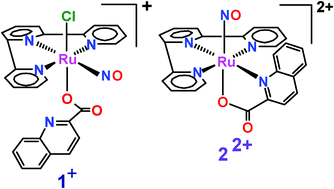The nitrosyl complexes, [RuII(trpy)(L)(NO+)Cl]BF4, [1]BF4, and [RuII(trpy)(L)(NO+)](BF4)2, [2](BF4)2, (trpy = 2,2′:6′,2′′-terpyridine, L− = deprotonated form of unsymmetrical quinaldic acid) have been synthesized. Single crystal X-ray structures of [1]BF4 and [2](BF4)2 reveal that in the former L− binds to the ruthenium ion selectively in a monodentate fashion through the O− donor whereas the usual bidentate mode of L− (O−, N donors) has been retained in [2](BF4)2 with the same meridional configuration of trpy being seen in both. The Ru–NO group in [1]BF4 or [2](BF4)2, exhibits almost linear (sp-hybridized form of NO+) geometry. The difference in bonding mode of the unsymmetrical quinaldate in [1]BF4 and [2](BF4)2 has been reflected in their corresponding ν(NO)/ν(C![[double bond, length as m-dash]](https://www.rsc.org/images/entities/char_e001.gif) O) frequencies as well as in their NO based two-step reduction processes, {RuII–NO+} → {RuII–NO•} and {RuII–NO•}→{RuII–NO−}. The close to bent geometry (sp2-hybridized form of NO•) of the one-electron reduced 1 or [2]+ is been reflected in their DFT optimized structures. The spin density plot of the reduced species reveals that NO is the primary spin-bearing center with slight delocalization onto the metal ion which has been reflected in its radical EPR spectrum. [1]+ and [2]2+ undergo facile photorelease of NO with significantly different kNO (s−1) and t1/2 (s) values which eventually lead to the concomitant formation of the corresponding solvent species. The photoreleased NO• can be trapped as an Mb–NO adduct. The reduced species 1 selectively reacts with the molecular oxygen (O2) at pH ∼ 1 to yield the corresponding nitro species, [RuII(trpy)(L)(NO2)Cl]−.
O) frequencies as well as in their NO based two-step reduction processes, {RuII–NO+} → {RuII–NO•} and {RuII–NO•}→{RuII–NO−}. The close to bent geometry (sp2-hybridized form of NO•) of the one-electron reduced 1 or [2]+ is been reflected in their DFT optimized structures. The spin density plot of the reduced species reveals that NO is the primary spin-bearing center with slight delocalization onto the metal ion which has been reflected in its radical EPR spectrum. [1]+ and [2]2+ undergo facile photorelease of NO with significantly different kNO (s−1) and t1/2 (s) values which eventually lead to the concomitant formation of the corresponding solvent species. The photoreleased NO• can be trapped as an Mb–NO adduct. The reduced species 1 selectively reacts with the molecular oxygen (O2) at pH ∼ 1 to yield the corresponding nitro species, [RuII(trpy)(L)(NO2)Cl]−.

You have access to this article
 Please wait while we load your content...
Something went wrong. Try again?
Please wait while we load your content...
Something went wrong. Try again?
![[double bond, length as m-dash]](https://www.rsc.org/images/entities/char_e001.gif) O) frequencies as well as in their NO based two-step
O) frequencies as well as in their NO based two-step 

 Please wait while we load your content...
Please wait while we load your content...